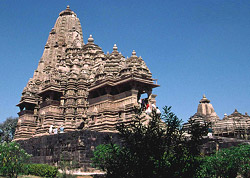 |
Encyclopedia of Tours and Travel to Madhya Pradesh, featuring information on Fairs & Festivals, Wildlife, Excursion, Adventure and Weather of Madhya Pradesh. |
 |
 |
 |
 |
 |
 |
 |
||
|
Madhya Pradesh
 Madhya
Pradesh has 48 districts and has Bhopal as its capital. This state
is not called the "Heart of India" only because of its location
in the centre of the country, but because of its features. This state
is a cluster of innumerable districts and varied topographic and climatic
characteristics. Madhya Pradesh consists largely of a plateau, spectacular
mountain ranges, meandering rivers, which adds to the natural beauty
and miles of dense forests offering unique and exciting scenery of
wildlife in sylvan surroundings. The famous Khajuraho temples are
also located here. A number of significant rivers like the Chambal,
Sone, Betwa, and other rivers flow from the western side of the state
to the east. Thus, with the mountain ranges and rivers, Madhya Pradesh
has a varied physical feature. Madhya
Pradesh has 48 districts and has Bhopal as its capital. This state
is not called the "Heart of India" only because of its location
in the centre of the country, but because of its features. This state
is a cluster of innumerable districts and varied topographic and climatic
characteristics. Madhya Pradesh consists largely of a plateau, spectacular
mountain ranges, meandering rivers, which adds to the natural beauty
and miles of dense forests offering unique and exciting scenery of
wildlife in sylvan surroundings. The famous Khajuraho temples are
also located here. A number of significant rivers like the Chambal,
Sone, Betwa, and other rivers flow from the western side of the state
to the east. Thus, with the mountain ranges and rivers, Madhya Pradesh
has a varied physical feature.
The forests cover a major part of the state. And the cultivated area accounts for almost half of the total landmass of the state. Madhya Pradesh is famous for its wonderful art, craft, music and dance. Rich in geographical varieties, the state also has a good number of important mines that has a good influence on the economy of the country. Since, most of the populace is engaged mostly in the agricultural activities, the state is the homeland of many tribal races. The economy of this state also includes the service sector, comprising of Real estate, Consultancies, Travel and Tourism, Educational Institutes, Hotel Industry and Insurance. Madhya Pradesh, which literally means 'Central India', is associated with some of the famous names in Indian History. If one grasps the knowledge of the long and turbulent history of this state, then it is very easy to realize as to how did the bumper crop of monuments have made their existence here.
The history of Madhya Pradesh goes back to the time of Ashoka, the great Mauryan ruler. The Chandelas built the fantastic monuments of Eros, Khajuraho, in the north of the state. The end of the first millennium saw the Central India being divided into several kingdoms. The Parmars, whose ruler Raja Bhoj founded Bhopal, controlled the southern and central area, known as Malwa. While the Chandelas, responsible for some of the subcontinents' most exquisite temples, were ruling in the North. Between 12th and 16th centuries, the region saw continuing struggles between Hindu and Muslim rulers and invaders. The fortified city of Mandu in the southwest, was the scene of frequent battles. Madhya Pradesh then fell into the hands of the Mughals. Under the British, the middle of India was known as the 'Central Province' and administered jointly from Nagpur and the summer capital Panchmarhi near Bhopal was the state's highest hill station. Madhya Pradesh, or M.P, only came into being after independence in 1956. This state in its present entity was formed out of former states
of Madhya Bharat, Vindhya Pradesh, Bhopal and fourteen (Mahakoshal)
districts of old Madhya Pradesh. The Central Provinces were amalgamated
with a number of smaller princely states. Since then, the 93% -
Hindu State, with a substantial rural and tribal population, has
remained more stable than the neighboring Uttar Pradesh and Bihar.
|
||||||||||||||||||||||||||||||||||||||||||||||||||||||||
|
||||||||||||||||||||||||||||||||||||||||||||||||||||||||
|
||||||||||||||||||||||||||||||||||||||||||||||||||||||||